
Traditional methods of rain enhancement focus on improving the efficiency of precipitation formation in natural clouds. For that purpose, based on much theoretical work, laboratory modeling and field campaigns, various technologies now exist which improve cloud seeding techniques. For example, we have seen improvements in the seeding materials such as the use of crystalline and hygroscopic agents, in the optimization of their dosage, and in the careful control over the critical time and place of seeding. However, in many arid parts of the world, there are few (if any) clouds for long periods of the year. For example, in the territory of the United Arab Emirates (UAE), up to 355 sunny days are registered annually, and from April to December inclusive, only 20 to 30 mm of precipitation falls (out of an annual total of ~130 mm).
The main idea behind this proposal is the stimulation of atmospheric convection to aid the formation of development of artificial large cumulus clouds. It is already known that wildfires and the fires connected with large military operations can produce pyro-convective clouds (Cunningham and Reeder, 2009; Fromm et al., 2010), which in certain cases can lead to cumulus and cumulonimbus clouds with significant precipitation.
During the 1950s and 1960s, France and the USSR experimented with methods to create artificial clouds through the use of “meteothrones” (in which fuel was burned in vertically directed aviation jet engines). The maximum power of a meteothrone was equivalent to about 103 MW, with the stream of ascending air reaching 100 to 1000m and higher (Levin et al., 1984; Kachurin et al., 1990). Under favorable conditions, the development of cumulus clouds was observed. But these practices were soon stopped because of their low efficiency, high cost and many associated environmental problems.
This project proposes to create artificial clouds and rainfall in a more environmentally friendly way by manipulating solar radiation. We aim to heat the lower atmosphere using solar radiation to stimulate artificial convection and cloud formation by a) the creation of an aerosol layer by burning grenades, which will effectively absorb visible solar radiation, and b) the raising of a garland containing a set of the black ‘toroids’ filled with helium. Further growth of the cloud is likely in certain atmospheric conditions, due to release of latent heat of condensation of water vapor.
According to preliminary theoretical modeling by our team, the most favorable atmospheric conditions for creation of artificial convective clouds include the existence of a surface atmospheric layer with relatively low windspeed, high relative humidity, and increased instability above the cloud condensation level. Also important is a shallow surface temperature inversion (which usually constrains the development of natural clouds). The requirements for these conditions is due to the following factors:
For creation of artificial convective clouds two methods are proposed:
A.The creation of an thermal jet stream spraying hygroscopic aerosols (by use of aviation engine and hygroscopic agent dissolved in water) in a near-ground atmospheric layer (with a temperature inversion) through the use of optimized aerosols with a maximum absorption of solar radiation in the wavelength bandwidth of 0.4 to 0.8µm. In an ideal case, we believe the thermal stream and optical thickness of the aerosol layer should lead to an overheating of the whole volume of air by several degrees Celsius. We estimate that this would lead to the creation of artificial vertical updrafts, which, in case of reaching condensation level (under given conditions), will lead to the formation of a convective cloud.
B.The creation of the HELIATOR device consisting of a multi-level system of fastened balloons in a toroidal (garland) form with blackened surfaces (Pavlyuchenko, Patent RU № 2462026, 2012), and filled with helium. At each tier, the blackened balloon surface is heated directly by the Sun (direct solar constant flux at TOA = 1367 W/m2) and transfers its heat to the surrounding air by convection. The ascending and expanding air is cooled adiabatically as it reaches the next level. The process repeated for all tiers, so that flexible and adjustable ascending flows of heated air are formed until they reach the level of water vapor condensation, stimulating formation of an artificial convective cloud and precipitation.
We propose to construct and apply Thermal Machine with use of decommissioned aviation turbojet engine. On the outlet of the nozzle a carbamide water solution can be sprayed, creating a finely dispersed hygroscopic aerosol having also an optimum dispersity for absorbing solar radiation.
There are several advantages of using thermal machine to create an aerosol layer:
a) Possibility of carrying out numerous (tens) full-scale experiments at the relatively small cost. The cost of materials (fuel and carbamide) per experiment is 20 times less than the cost of smoke checkers required for one experiment.
b) Faster creation of an aerosol cloud. For example, a horizontal jet of a turbofan dual-circuit D-30 aircraft engine in 1 min can create a superheated aerosol cloud having volume of more than 100000 m3.

The Soloviev D-30 (PS-30) is a Soviet two-shaft low-bypass turbofan engine, officially referred to as a “bypass turbojet.” A supersonic afterburner version, the D-30F6, is used in the Mikoyan-Gurevich MiG-31 interceptor, while the non-afterburning civilian versions, the D-30Kp and D-30KU are used in the Ilyushin Il-62M and Tupolev Tu-154M airliners, and in the Ilyushin Il-76MD, TD heavy cargo aircraft.
c) The aerosol cloud will have an initial temperature about 500-1000 оC and huge buoyancy that can lead to the stimulation of thermal convection immediately after the engine starts.
d) Vertically directed jet, according to experiments conducted in France and Cuba (Dessens, 1963), in USSR (Vulfson and Levin, 1966-1968; Kuznetsov and Konopasov, 1969-1972), can rise in a stable atmosphere up to elevation 300 – 500 m, in a weakly stable atmosphere up to 500 – 1500 m, and in the presence of highly instable layer up to 1500 – 4500 m, leading to the formation of a convective cloud and precipitation.
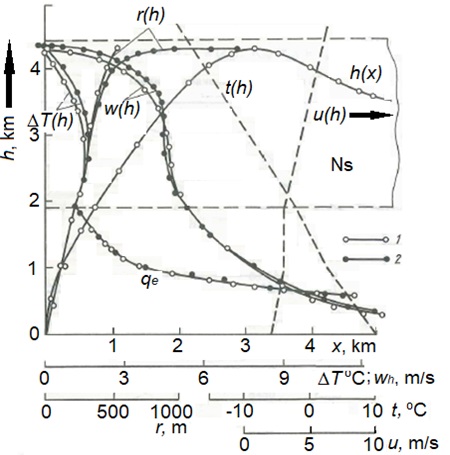
Simulated parameters of thermal jet at a horizontal wind speed:
Carbamide (diamidugolic acid) is a white, water-soluble, non-toxic, non-flammable, explosion-proof substance without odor, which is made from ammonia and carbon dioxide. In Russia carbamide is produced by 14 large plants, including JSC “Nevinnomyssky azot” (200 km from Nalchik), which produces about 1 million tons per year. Price»0.18 $/kg. Carbamide is a widely used fertilizers of the soil before planting and during the growing season of plants. Carbamide is a supplier of nitrogen, which facilitates the collection of green mass plants and significantly increases yield. In addition, carbamide is used in: In medicine, for the manufacture of drugs that remove water from the human body and hypnotic drugs; o In the food industry – as an enhancer of the taste and aroma of food products, to improve the quality of flour, bakery products, chewing gum taste, etc.;In the livestock for feeding ruminants; In the oil industry – to remove paraffinic substances from oils and fuels;In ecology – for the purification of nitrogen oxides of smoke from pipes of garbage disposal plants, boiler houses and thermal power.

The proposed method would increase the probability of creating artificial clouds due to set of accompanying factors:
The probability of such a scenario is increased with an increase in the atmospheric moisture content and altitude above sea level. Therefore, full-scale experiments (with the preparation of the necessary infrastructure) should be carried out in the mountains, where it is easier to reach the level of condensation.
At the moment we prepare CFD models (FlowVision package) for carrying out numerical simulations to confirm this concept.
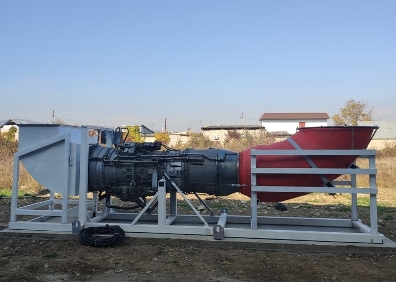
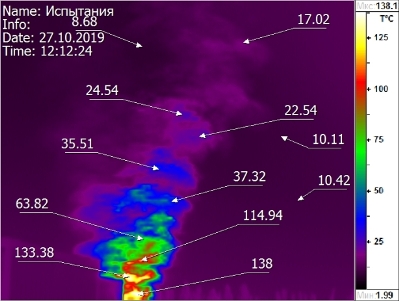
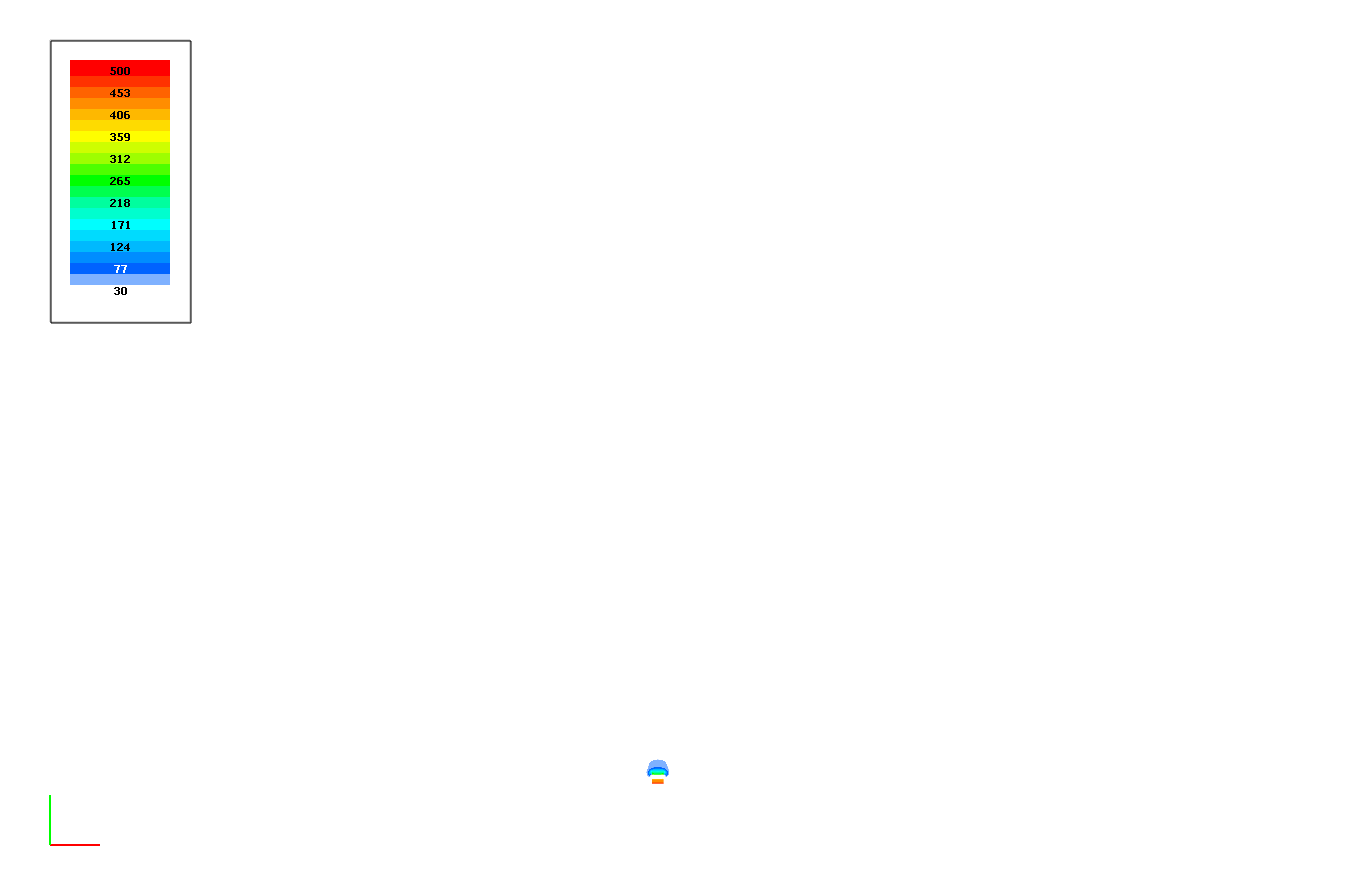

The HELIATOR device (Pavlyuchenko, 2012) consists of multi-level system of the fastened balloons containing cylinders coated with a black surface which gets warm by absorbing solar radiation. This creates an ascending airstream enriched with the ions promoting condensation (Rusanov et al., 1978). These ions can be generated at the expense of the corona discharges from needle emitters (Tokarev et al., 2009).
The black cylinders of the HELIATOR consists of tiers in the form of the toroids filled with light gas (helium or hydrogen) which provide the lifting power (Figure 3). In the simplest case each tier represents the toroid formed by circular shape and the cylindrical sleeve attached to a round frame. The frame provides sufficient rigidity for each tier which are fastened to durable ropes. Between each frame and its center, the wires are kept tense, much like an analog of a bicycle wheel with spokes. The continuous black cylinder can be replaced with the standard balloons with a diameter 2.5 m composed of a straightforward black metallized synthetic film of good heat conductivity (such as Mylar, which holds gas well and is unreactive against ultraviolet radiation).
This type of modular structure simplifies its assembly and adjustment, and increases its survivability even when the balloons are damaged. Each tier has a diameter of 20 m, each balloon has a diameter of 2.5m, with 20 balloons on each rim, yielding a gross weight of 50 kg. The total lifting power is 164 kg with helium or 200kg with hydrogen. Several such tiers (10-15 levels) are located one above another and are connected by cables. These cables are made of synthetic fibers (kevlar, kapron) and fasten to the winches, one of which is grounded as an isolated conductor to prevent build-up of electric charge.
The HELIATOR device works as follows. In cloudless or slightly cloudy days, the tiers of cylinders are united by the uniform system of fastened cables. The blackened cylinders of all tiers heats up by absorption of solar radiation and release the heat into the air. The shape of the device means that, in each tier or ring, warm air is formed and is allowed to freely convect. Warm air rises up with Archimedes acceleration, being gradually cooled adiabatically because of expansion, and through turbulent mixing with the ambient air. The vertical distance between each tiers is carefully selected so that air in the ascending stream reaches the next tier with only a minimal amount of cooling.
In the Figure b and Figure 3, for example, the result of a simulation for an ascending airstream for two lower tiers of the HELIATOR system using the computer software package suites ANSYS and FlowVision are presented. In this case, the temperature of heated cylinders is set to 40ºC, with the air temperature at 20ºC, diameter of each tier is 20 m, the diameter of a cylinder is 3 m, the distance between the tiers is 25 m, and the height of the lower tier above the ground is 10 m. From Figures 3b/3c it can be clearly seen that a strong vertical stream of air is generated, originating mostly from the lower part of a near-surface layer.
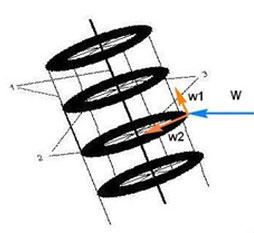

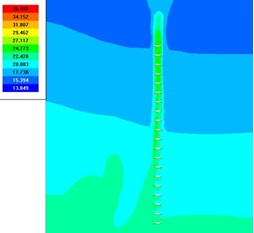

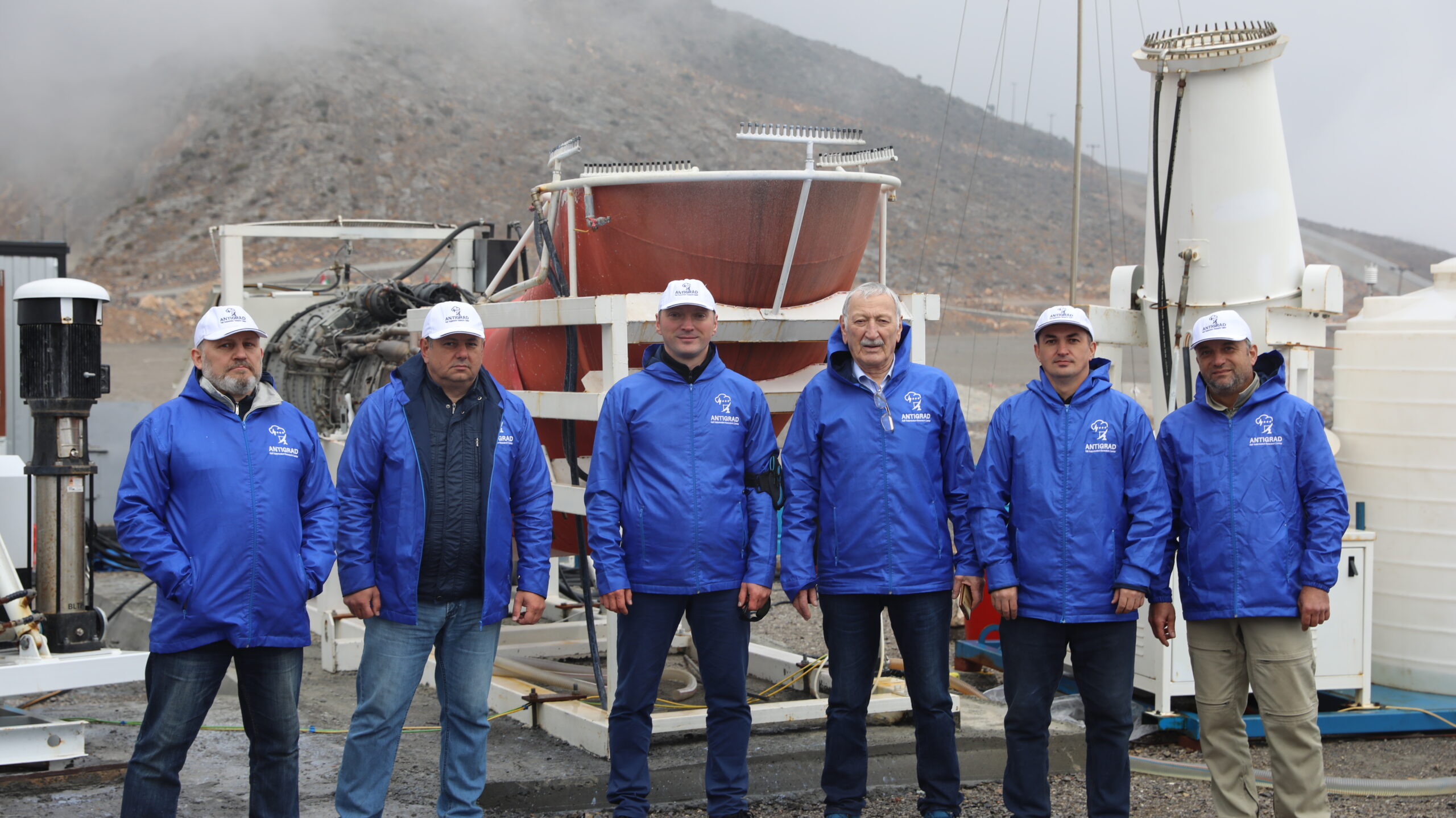
The project team has extensive experience and performance in high-level international scientific research, as well as in educating young scientists in the field of weather modification, clouds physics and meteorology. This experience will be tapped into during project to benefit the scientific capacity building of the UAE research community. We strongly believe that capacity building is best realized through active involvement and education of researchers during the project work. Our project includes both in-situ experimental and theoretical/modelling work, where capacity building takes on different forms for these aspects of the project.
The project includes one-year of extensive numerical simulation and data reanalysis, one year of designing and manufacturing of the special technologies and constructions, and one year of in-situ observations of several critical atmospheric parameters and field experiments on the initiation thermal convection in Russia and in the UAE, with the direct participation of young scientists and students from UAE.
These observations and experiments require complex state-of-the-art instrumentation, which in turn requires special training of the operating personnel. Whilst the project consortium will be providing the measurement hardware directly, continuous operation of the instrumentation requires training the local staff for the upkeep and maintenance of the instruments. The training will be arranged both prior and during the field experiment at the relevant UAE measurement site(s). The technical staff will also be involved in the scientific analysis of the measured data to ensure that their knowledge of the local everyday conditions is incorporated in the analysis.
We have reserved funding for research and study exchanges of UAE scholars and students to enable them to make research visits to the second and third year during execution of the field experiments. Furthermore, the project researchers will also be available to teach relevant short-term science courses (e.g. on thermal convection and clouds formation, numerical simulation on the basis of FlowVision package suite and 3D cloud resolving model, measurement techniques, etc.) at collaborating local universities. Preliminary discussions concerning educational activities have already been started with the United Arab Emirates University (Assoc. Prof. Reyad El-Khazali, Khalifa University), but are not necessarily limited to this one University.
The field experiments in the UAE will be performed in close co-operation with local academic collaborators, the existing measurement facilities, and possibly some previously funded projects under the UAE Research Program for Rain Enhancement Science. Within such collaborations, one of the most effective ways of promoting knowledge transfer is joint research (V.Wulfmeyer, L.Zou and H.Korhonen). Therefore, we will actively encourage and promote joint research activities, as well as provide access and assistance to our data for the other collaborators. These day-to-day endeavors will be supported by organizing dedicated joint workshops, for which we have reserved targeted funding in the project budget.
The natural power of fully-developed clouds to produce precipitation is tremendous, but precipitation processes are vulnerable to weak physical, chemical or mechanical impacts which can lead to significant changes in their natural development. For example, the atmosphere always contains large amount of water vapour, but cloud formation is constrained by quasi-permanent temperature inversion. In these cases it is required to correct only a few natural conditions – to “punch a hole” in a layer of temperature inversion and to provide conditions for development of clouds and formation of rainfall. This project is intended exactly on solving of this problems. For achievement of this purpose it is offered to reveal such situations and by means of heating of local sites of the ground atmosphere at the expense of solar radiation (i.e. a rather small artificial influence) to help to realize the full energy of instability above the temperature inversion.
The project provides basic theoretical and experimental studies to create artificial convective clouds and to cause a rain in an otherwise cloudless situation. It is quite a solvable task, such as when forest and other fires lead to formation of the convective clouds reaching a storm stage of development. It is only necessary to study these conditions and to reproduce them artificially.
The success of this project with the possibility of yielding a regular increase in rainfall and providing water for agriculture and other needs, will permit the UAE to become the global leader in use of new technology to increase precipitation. This proposed project’s technology is not complex and the project team will do everything to provide for its reproducibility.
The project management team consists of 8 scientific leaders from 4 of the different countries. Experiments of the innovative method will be made with involvement of students of Khalifa University. The project team will give lectures and a practical training course on how to carry out the field experimen

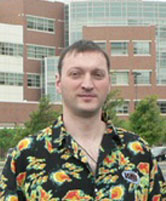
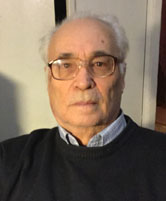
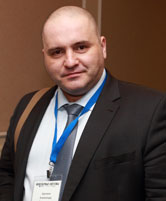
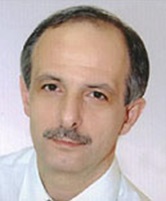
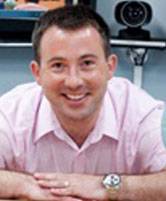

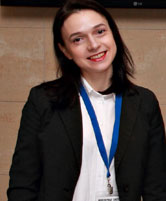


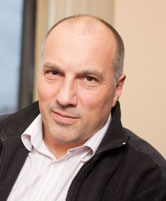
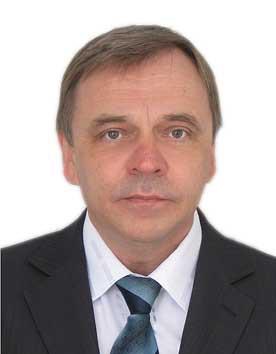
1) Ali Abshaev, Magomet Abshaev, Viktor Pavlyuchenko, Alexander Shelyaev, Julia Fisher, Andrey Aksenov, Edward Graham. Geophysical Research Abstracts – On the way of searching possibilities of stimulation local atmospheric convection and aid formation of clouds, Vol. 21, EGU2019-PREVIEW, 2019. https://meetingorganizer.copernicus.org/EGU2019/EGU2019-6129.pdf
2) Abshaev, M.T.; Zakinyan, R.G.; Abshaev, A.M.; Al-Owaidi, Q.S.K.; Kulgina, L.M.; Zakinyan, A.R.; Wehbe, Y.; Yousef, L.; Farrah, S.; Al Mandous, A. Influence of Atmosphere Near-Surface Layer Properties on Development of Cloud Convection. Atmosphere 2019, 10, 131. https://doi.org/10.3390/atmos10030131
3) Pavlyuchenko, V.P. Generation of Artificial Updrafts in the Atmosphere by a Multilevel Facility. Bull. Lebedev Phys. Inst. 46, 165–169 (2019) https://link.springer.com/article/10.3103/S106833561905004X
4) Magomet T. Abshaev, Ali M. Abshaev, Robert G. Zakinyan, Arthur R. Zakinyan, Youssef Wehbe, Latifa Yousef, Sufian Farrah, Abdulla Al Mandous, Investigating the feasibility of artificial convective cloud creation, Atmospheric Research, Volume 243, 2020, 104998, ISSN 0169-8095, https://doi.org/10.1016/j.atmosres.2020.104998
5) Magomet T. Abshaev, Ali M. Abshaev, Andrey A. Aksenov, Iuliia V. Fisher, Alexander E. Shchelyaev, Abdulla Al Mandous, Youssef Wehbe & Reyad El-Khazali. CFD simulation of updrafts initiated by a vertically directed jet fed by the heat of water vapor condensation. Sci Rep 12, 9356 (2022). https://doi.org/10.1038/s41598-022-13185-2
6) Magomet T. Abshaev, Robert G. Zakinyan, Ali M. Abshaev, Arthur R. Zakinyan, Roman D. Ryzhkov, Youssef Wehbe, Abdulla Al Mandous, Atmospheric conditions favorable for the creation of artificial clouds by a jet saturated with hygroscopic aerosol, Atmospheric Research, 2022, 106323, https://doi.org/10.1016/j.atmosres.2022.106323.
7) Abshaev, M.T., Abshaev, A.M., Aksenov, A.A., Fisher, I.V., Shchelyaev. Simulation of large-scale convective atmospheric currents in the FlowVision PC. Conf. Parallel computing technologies (PaVT’2022), p. 68-81, 2022 https://www.elibrary.ru/item.asp?id=48553729
https://flowvision.ru/images/2022/articles/Modelirovanie-konvektivnyh-atmosfernyh-techenij-bolshogo-masshtaba-v-PK-FlowVision.pdf
https://flowvision.ru/ru/flowvision-applications/modelirovanie-konvektivnykh-atmosfernykh-techenij-bolshogo-masshtaba-v-pk-flowvision
http://omega.sp.susu.ru/pavt2022/talks/Fisher.pdf
8) Abshaev, M.T.; Abshaev, A.M.; Aksenov, A.A.; Fisher, J.V.; Shchelyaev, A.E.; Mandous, A.A.; Wehbe, Y.; El-Khazali, R. Study of the Possibility of Stimulating Cloud Convection by Solar Radiation Energy Absorbed in an Artificial Aerosol Layer. Atmosphere 2023, 14, 86. https://doi.org/10.3390/atmos14010086
9) Abshaev, M.T.; Abshaev, A.M.; Aksenov, A.A.; Fisher, J.V.; Shchelyaev, A.E.; Al Mandous, A.; Al Yazeedi, O.; Wehbe, Y.; Sîrbu, E.; Sîrbu, D.A.; Eremeico, S. Results of Field Experiments for the Creation of Artificial Updrafts and Clouds. Atmosphere 2023, 14, 136. https://doi.org/10.3390/atmos14010136
10) Abshaev, A. M., Abshaev, M., Zakinyan, R., Zakinyan, A., Wehbe, Y., Al Mandous, A., El-Khazali, R., Aksenov, A., Fisher, I., Shchelyaev, A., Ivanov, V., Al Mazroui, A., Sufian, F., Nikolai, S. (2023): Theoretical and experimental studies of stimulating cloud forming convection in the UAE, XXVIII General Assembly of the International Union of Geodesy and Geophysics (IUGG) (Berlin 2023). https://doi.org/10.57757/IUGG23-2614
11) Magomet Tahirovich Abshaev, Abshaev Ali M., Andrey A. Aksenov, J. Fisher, Alexander E. Schelyaev. Simulation results of field experiments on the creation of updrafts for the development of artificial clouds and precipitation, August 2023 Computer Research and Modeling 15(4): 941-956, DOI: 10.20537/2076-7633-2023-15-4-941-956
1) Patent 2732710. C1 RU IPC, A01G 15/00(2006.01). The method of creating artificial clouds and precipitation / Abshaev M.T., applicant and patent holder Abshaev Magomet Takhirovich (RU), “Hail Suppression Research Center “Antigrad” (RU), National Center for Meteorology of the United Arab Emirates (AE). – No. 2019110769, application 04/11/19, published 09/22/20, Bulletin No. 27.
2) Patent 2738479. C1 RU IPC, A01G 15/00(2006.01). Method and device for creating artificial clouds and precipitation / Abshaev A.M.; Abshaev M.T., Al Mandous Abdulla, applicant and patent holder Abshaev Magomet Takhirovich (RU), “Hail Suppression Research Center “Antigrad” (RU), National Center for Meteorology of the United Arab Emirates (AE) .- No. 2020123371 ; application 07/14/20; published 12/14/20 Bulletin No. 35.
3) PCT/RU2021/050182, Abshaev A.M., Abshaev M.T., Mandous Abdulla Ahmed Al, Method and deivce for creating artificial clouds and precipitation, A01G15/00; B01D5/00; E03B3/02; E03B3/28, Publication Date:January 20, 2022.
4) Patent 2803352. C1 RU IPC, A01G 15/00(2023.02). Method for creating artificial clouds and precipitation / Abshaev M.T.; Abshaev A.M., Al Mandous Abdulla, applicant and patent holder Abshaev Magomet Takhirovich (RU), “Hail Suppression Research Center “Antigrad” (RU), National Center for Meteorology of the United Arab Emirates (AE) .- No. 2022130418; application 24/11/2022; published 12/09/2023; Bulletin No. 26.
This material is based on work supported by the National Center of Meteorology, Abu Dhabi, UAE under the UAE Research Program for Rain Enhancement Science.
Any opinions,findings and conclusions or recommendations expressed in this material are those of the author(s)and do not necessarily reflect the views of the National Center of Meteorology, Abu Dhabi,UAE,funderof the research.